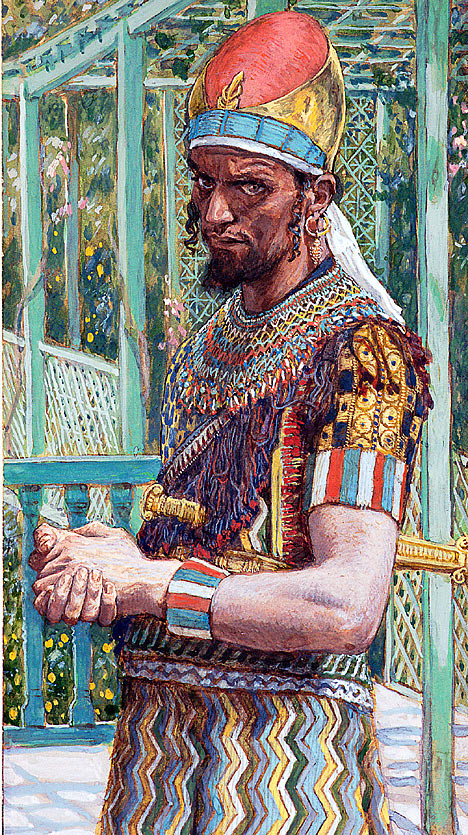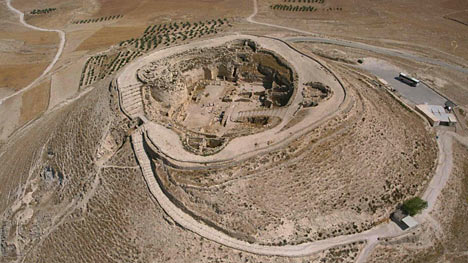
|
|||
Herod's Lost Tomb
The archeologist who located King Herod's tomb at Herodium said that the grave had been desecrated, apparently shortly after his death, but called the discovery a "high point." The Hebrew University of Jerusalem announced Monday night that it has uncovered the grave and tomb of Herod, who ruled Judea for the Roman empire from circa 37 BCE. Professor Ehud Netzer of the university's Institute of Archaeology told reporters Tuesday that the tomb was discovered when a team of researchers found pieces of a limestone sarcophagus believed to belong to the ancient king. Although there were no bones in the container, he said the sarcophagus' location and ornate appearance indicated it was Herod's. "It's a sarcophagus we don't just see anywhere," Netzer said. "It is something very special." Netzer led the team, though he said he was not on the site when the sarcophagus was found. He said the sarcophagus had been smashed into pieces, most likely by someone seeking revenge on Herod during the great Jewish rebellion of 66-72 CE.
Herod governed by consent of the Roman emperors whose dominion stretched over most of the eastern Mediterranean and down to Egypt, under Cleopatra. They regarded Herod as a useful puppet king, able to keep the oftenrebellious Israelites in order. They were not too interested in his methods, though the Emperor Augustus was reported to have said: 'It is better to be Herod's dog than one of his children.' What prompted the remark was the pile of corpses of Herod's family that grew in the courtyard of his palace. In 35BC, he had his brother-in-law, the High Priest Aristobulus, drowned because he suspected him of disloyalty. Another brother-in-law, Kostobar, was killed soon afterwards. His sons by Mariamne, Alexandros and Aristobulus, were both killed on his orders. Another son, Antipas, was executed for treason. It is not hard to see why, for many Jews, the much-married Herod was a hated figure. Herodium, a fortified palace built by Herod some 12 kilometers south of Jerusalem, was destroyed by the Romans in 71 CE. Herod, whose father and grandfather converted to Judaism, was appointed governor of Galilee at the age of 25 and was made "King of the Jews" by the Roman senate in approximately 40 BCE. He remained king for around 34 years. Herod, also known as Herod the Great, is credited with expanding the Second Temple and building Caesarea, Masada, and many other monumental construction projects. He died in the year 4 BCE in Jericho after a long illness. Herod decided to construct his tomb at Herodium because the site played a role in two dramatic events in his life. In the year 43 BCE, when Herod was still governor of the Galilee, he was forced to flee Jerusalem along with his family after his enemies the Parthians laid siege to the city. His mother's chariot flipped over near Herodium, and Herod became hysterical until he realized she was only lightly wounded. A short while later, the Parthians caught up to Herod and his entourage, although Herod and his men emerged victorious in the ensuing battle. At Herodium, Herod built one of the largest monarchical complexes in the Roman Empire, which served as a residential palace, a sanctuary, an administrative center and a mausoleum. Herod first built an artificial cone-shaped hill that could be seen from Jerusalem, on which he constructed a fortified palace surrounded by watchtowers that he used solely in wartime. At the base of the hill, he built an additional palace, which was the size of a small town and known as "Lower Herodium." The palace included many buildings, fancy gardens, pools, stables, and storage areas. Herod spared no expense in an attempt to turn the site into a regional gem, bringing water from Solomon's Pools and special soil to allow his gardens to blossom in the heart of the desert. Following Herod's death, his son and heir Archilaus continued to reside and Herodium. After Judea became a Roman province, the site served as a center for Roman prefects. With the outbreak of the Great Revolt, Herodium was seized by the rebels, but then handed over without resistance to the Romans following the fall of Jerusalem in 70 CE. Fifty years later, Herodium was also used by the rebels during the Bar Kokhva revolt, but was abandoned thereafter. In the 5th century CE, the site was settled by Byzantine monks, and then served as a leper colony before being finally abandoned in the 7th century CE. The first archeological dig at the site, between the years 1956 and 1962, was conducted by a Franciscan monk and revealed most of the currently-known remains. Israel began excavations at the site in 1972, several years after its capture during the Six-Day War Watch more on Herod's Lost tomb on National Geographic on Sun Nov.23 9PM. Liked it ? Want to share it ? Social Bookmarking Discuss and comment on article | Article Link | Source : Website | Return to Unexplained Mysteries |
More can be addded on request. Direct your requests at vinit@theunexplainedmysteries.com






